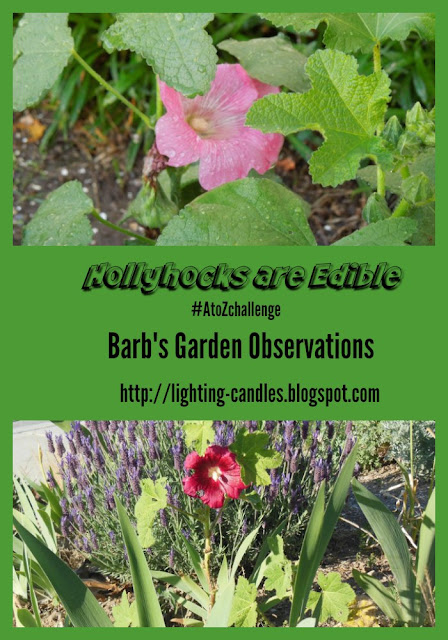 |
| Hollyhock and French Sage, © B. Radisavljevic |
I already knew that hollyhocks are drought resistant and can grow, if not thrive, in poor soil. The painted lady butterflies also love to visit them. So far I haven't seen them visit mine, but I only have a couple of plants. I'd love to have a group of tall ones such as the ones next to this elderberry tree at the now closed Fat Cat Herb Farm.
 |
| Hollyhocks and Elderberry Tree at Fat Cat Farm, © B. Radisavljevic |
I loved that place, and almost cried when it closed. I had been patronizing first Sycamore Farms and then Fat Cat Farm to buy my organically grown herbs for twenty years. Fortunately I can now multiple most of the herbs I purchased from them with cuttings and root divisions.
I don't know why it surprised me so much today to learn that I could eat hollyhocks in the same way I eat mallow. I understand the leaves are a bit tougher in salads, but that could probably be fixed by massaging them as demonstrated in this video. I now do this for kale and chard and any other tough green. The only downside I see in eating hollyhock leaves raw is that the leaves, unlike the smoother mallow leaves, have a fuzzy surface. I tried part of one this morning.
My research indicates that all parts of the hollyhock are edible -- leaves, flowers stems, roots, and seeds. Since I just learned this today, I'm not offering recipes just yet. Stay tuned. Since I use mallow leaves in soups, I would for sure use hollyhock leaves the same way. I'm not sure yet if they thicken soups and stews the way mallow leaves do.
I am now planning to grow more hollyhocks and pay more attention to them. My goal is to have as many edible flowers as possible. The hollyhock below is in very poor soil and doesn't get much water. Still it blooms and came back this year. The purple flowers you see in the background are French sage.
 |
| Hollyhock and French Sage, © B. Radisavljevic |
The pink hollyhock below grows in my front flowerbed. Even though I did not cut it back to the ground last year, it is budding again. This was a shy flower, hiding behind the leaves.
 |
| Shy Pink Hollyhock, © B. Radisavljevic |

If you enjoyed this post, please share it. The sharing buttons are just above the comment box at the end of this post. The photo below is especially designed for pinning.
This is my eighth post for the 2016 AtoZchallenge, a Blogging Challenge for the month of April, 2016. My theme is plants, since this is a gardening blog. Here are links to the other posts if you missed them.
A is for Apple Blossoms
B is for Bottlebrush
C is for Carnations
D is for Daisy
E is for Elderberry
F is for Flowers
G is for Gazania




7 comments:
Barb, thank you so much for this post! Hollyhocks have been one of my favorite flowers since I was a small child. They signal hot summer days, picnics, at times bright spots of color in a searingly dry landscape, and never fail to trigger memories of one of the kindest men I ever knew.
But I didn't know they were edible. I look forward to learning how you use them in recipes as well as how you like their taste.
Gorgeous pictures and thanks for sharing how they are edible! Enjoyable post!
Thank you for visiting, Donna.
Interesting to learn that they are edible. I'm wondering how well they'd grow on their own. I've been trying to grow edible plants, but since I'm usually not around, they all have to survive on their own without any help from me. I've got lemon and lime trees, those are doing great- some grapes, pineapples and pomegranate might do something soon.
Jill, maybe you should consider more of the wild edible plants like weeds. They grow very well on their own. Trees often do better because they don't require as much irrigation. herbs like rosemary and sage also do very well without much care. If you have drip irrigation, the edible flowers like hollyhocks and calendulas will do just fine. Calendulas can survive with very little water.
I did not know you could eat hollyhocks. What a great book. Great blog.
Visiting from A to Z.
One thing I love about blogging is that I learn so much in the process. This week I just learned that two flowers have edible parts that I didn't know did.
Post a Comment